Scottish Health Survey 2016 - volume 1: main report
Statistics relating to the health of people living in Scotland.
2 Smoking
Linsay Gray and Alastair H Leyland
Summary

- The mean number cigarettes smoked per day in 2016 was higher for male smokers (13.7 cigarettes) than for female smokers (11.7 cigarettes).
- Current smoking prevalence was highest among adults aged 25-54 (24-29%), however those in the 55-64 age group reported smoking the most cigarettes per day on average (15.1 cigarettes) of all adult age groups.
- Smokers were more likely to be a normal weight (BMI 18.5-less than 25) (39%) than ex-regular smokers (29%) or those who had never smoked (33%).
- The percentage of adults who had never or never regularly smoked was highest in the least deprived areas (65%; age-standardised for 2013-16 combined) and lowest in the most deprived areas (41%).
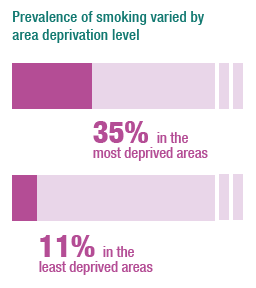
- Levels of current e-cigarette usage among adults had increased significantly from 5% in 2014 to 7% in 2015, and stayed at the same level in 2016.
- Current e-cigarette use was the same for men and women (7%) in 2016.
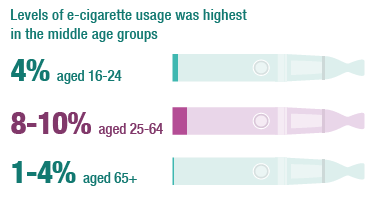
- Those living in the two least deprived area quintiles were the least likely to be exposed to second-hand smoke in their home or the homes of others (5-8%) and those in the most deprived quintile were the most likely (20%), (age standardised).
- Exposure of children to secondhand smoke in their home decreased from 11% in 2014 to 6% in 2015 and remained around this level in 2016 (7%).
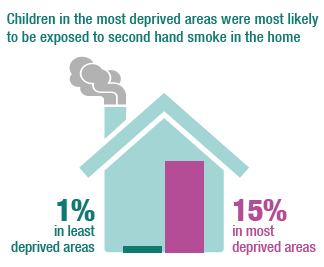
2.1 Introduction
Nationally[1] and globally[2], tobacco use is the leading cause of premature mortality and preventable poor health. Tobacco use is associated with stillbirths and infant deaths, childhood respiratory diseases, and communicable as well as non-communicable diseases in adulthood[3]. Each year tobacco use costs over half a trillion dollars worldwide and kills around six million people[4]. More than five million of the deaths are caused by direct tobacco use while more than 600,000 are the consequence of non-smokers being exposed to second-hand smoke[5]. In Scotland alone, tobacco use is associated with around 10,000 deaths each year (around a fifth of all deaths)[6].
2.1.1 Policy background
Tobacco control policies have led to significant declines in adult smoking levels in Scotland in recent decades[7]. Several of the Scottish Government’s National Indicators are relevant to smoking[8]. In addition to the specific indicator to reduce the proportion of adults who are current smokers (measured using SHeS data), there are more general related indicators on, for example, improving self-assessed general health, reducing premature mortality and reducing emergency admissions to hospital[9].
The Tobacco Control Strategy[10] lays out the Scottish Government’s vision to create a ‘tobacco-free generation’ (defined as ‘a smoking prevalence among the adult population of 5% or lower’) by the year 2034. Actions arising from the strategy are structured around the themes of prevention, protection and cessation. Smoking cessation interventions, including pharmacotherapy, are among the most cost-effective health care interventions available[11].
The strategy sets out a number of key actions for local authorities and partners including full implementation of smoke-free policies for local authority grounds, working with COSLA, NHS Health Scotland published guidance in January 2018 to facilitate such action[12]. The NHS Local Delivery Plan (LDP) Standards require NHS Boards to sustain and embed successful smoking quits at twelve weeks post quit, in the 40% most deprived SIMD areas (60% in the Island Boards)[13].
The Health (Tobacco, Nicotine etc. and Care) (Scotland) Act 2016 was commenced on 1 April 2017. The Act includes provisions to regulate:
- the introduction of a minimum age of 18 for the sale of Nicotine Vapour Products (NVPs) – including electronic cigarettes.
- a ban on the purchase of NVPs on behalf of an under 18 – ‘proxy purchase’.
- the introduction of mandatory registration for the sale of NVPs.
- bans on certain forms of domestic advertising and promotion of NVPs.
- the introduction of an age verification policy for sales of tobacco and NVPs by under 18s (‘Challenge 25’).
- a prohibition on the sale of NVPs from vending machines.
- a ban on unauthorised sales of tobacco and NVPs by under 18s.
- the introduction of statutory smoke-free perimeters around buildings on NHS hospital sites.
Regulation on the first four of these provisions came into force on 1 April 2017. Regulations on the other provisions will follow later in 2017.
The most recent passed Scottish Parliament legislation is the Smoking Prohibition (Children in Motor Vehicles) (Scotland) Act 2016 which deems as an offence smoking in cars in a public place in the presence of children[14].
All across the UK new regulations came into force on 21 May 2017 making it an offence to sell cigarettes in any pack containing less than 20 cigarettes, and ensuring all cigarettes are sold in standardised brand-neutral packs.
These new regulations also restricted the strength, availability and access to electronic cigarettes – banning cross-border advertising and promotion on, TV, radio, online, by e-mail and in print media.
2.1.2 Reporting on smoking in the Scottish Health Survey (SHeS)
Reliable data on smoking behaviour, cessation, Nicotine replacement therapy (NRT) use and exposure to second-hand smoke are vital to effective monitoring of trends relevant to the various targets in place. From 2014, SHeS has gathered information on the use of e-cigarettes among the Scottish adult population, in response to their increased availability and high profile.
This chapter presents figures for prevalence of cigarette smoking, e-cigarette use and non-smokers' and children’s exposure to second-hand smoke. It also considers smoking prevalence by BMI. The area deprivation data presented for cigarette smoking are presented in Scottish Index of Multiple Deprivation (SIMD) quintiles. Where appropriate, to ensure that comparisons are not confounded by different age profiles within categories, data have been age-standardised. Readers should refer to the Glossary at the end of this Volume for a detailed description of SIMD, BMI and age-standardisation. Supplementary tables are also available on the Scottish Government SHeS website[15].
2.1.3 Comparability with other UK statistics
The Health Survey for England, Health Survey for Northern Ireland and the National Survey for Wales provide estimates of smoking prevalence in the other home nations within the UK. The surveys are conducted separately and have different sampling methodologies, so smoking prevalence estimates across the surveys are only partially comparable[16]. Smoking prevalence estimates from the UK-wide Integrated Household Survey for Scotland, Wales, England and Northern Ireland have been deemed to be fully comparable[17].
2.1.4 Adolescent smoking in Scotland
Smoking rates for 13 and 15 year olds are available from The Scottish Schools Adolescent Lifestyle and Substance Use Survey (SALSUS). This survey is conducted on a biennial basis, targeting secondary school pupils in local authority and independent schools[18].
2.2 Methods And Definitions
2.2.1 Methods of collecting data on smoking behaviour
Adults aged 20 and over were asked about their smoking behaviour during the face to face interview. For those aged 16 and 17, information was collected in a self-completion questionnaire offering more privacy and reducing the likelihood of concealing behaviour in front of other household members. At the interviewer’s discretion those aged 18 and 19 could answer the questions either face to face or via the self-completion booklet.
2.2.2 Questions on smoking behaviour
Questions on smoking have been included in SHeS since 1995. Some small changes were made to the questions in 2008 and 2012. These are outlined in the relevant annual reports[19,20].
The current questions in the survey focus on:
- current smoking status
- frequency and pattern of current smoking
- the number of cigarettes smoked by current smokers
- ex-smokers’ previous smoking history
- exposure to second-hand smoke
- past smoking behaviour
- quit attempts and desire to give up smoking
- medical advice on giving up smoking
- NRT use
- e-cigarette use (including as part of a quit attempt)
While the self-completion questions were largely similar to those asked in the face to face interview, the self-completion questionnaire did exclude questions on: past smoking behaviour, desire to give up smoking and medical advice to stop smoking.
2.2.3 Definitions
Cigarette smoking status
Information on cigar and pipe use is collected in the survey but as prevalence is low these are not considered in the definition of current smoking. Smoking status categories reported here are:
- current cigarette smoker
- ex-regular cigarette smoker
- never regular cigarette smoker
- never smoked cigarettes at all
Exposure to second-hand smoke
Exposure to second-hand smoke for adults and children is measured in two ways in the survey:
- whether there is someone who regularly smokes inside the accommodation where the child lives, and
- parents’ and older children’s (aged 13-15) reports of whether children are exposed to smoke at home.
2.3 Cigarette Smoking Status
2.3.1 Trends in cigarette smoking status since 2003
Current smoking prevalence for all adults (aged 16 and over) dropped significantly from 28% in 2003 to 21% in 2013; since then, the figures have remained almost static at 21-22% (21% in 2016). Figures for men and women indicate that both sexes have followed a similar pattern of downward trend and subsequent stabilising (see Figure 2A).
The percentage of adults who had never smoked regularly or had never smoked at all increased from 50% in 2003 to 55% in 2011. There has been no significant change in the time period since, with the proportion of adults who had never smoked ranging from 54-55% between 2012 and 2016. The percentage of all adults reporting that they were ex-regular smokers increased significantly overall between 2003 (22%) and 2016 (24%). The trends in those reporting that they had never smoked or were ex-regular smokers were similar for men and women.
Overall, there was a significant fall over time in the mean number of cigarettes smoked per day by current adult smokers: the mean dropped from 15.3 cigarettes in 2003 to 12.6 in 2015 and remained around this level (12.7 cigarettes) in 2016. The decrease was seen for both male smokers (15.9 cigarettes per day in 2003 to 13.7 in 2015) and female smokers (14.7 cigarettes and 11.7, respectively).
Figure 2A, Table 2.1
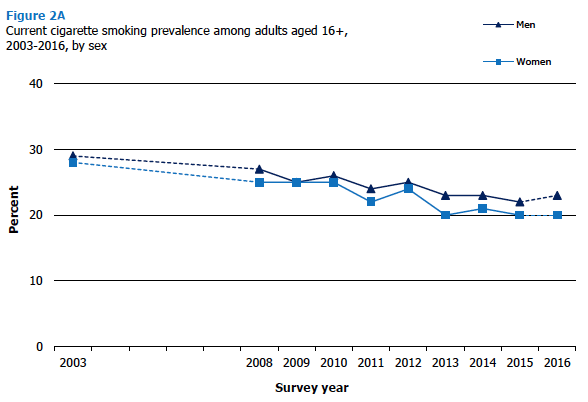
2.3.2 Cigarette smoking status in 2016, by age and sex
Smoking prevalence among adults in 2016 was 21% in 2016. The remainder was comprised of 24% adults who used to smoke regularly and 55% who reported that they had never smoked (regularly or at all).
The three percentage point difference between the proportions of male and female smokers (23% and 20% respectively) was not significant. However men were significantly less likely than women to have never smoked / or never been regular smokers (52% among men and 58% among women).
As seen in previous years,[21] there were significant differences in smoking prevalence between age groups in 2016. Smoking prevalence was highest among adults aged 25-54 (24-29%), lower among those aged 16-24 (21%) and those aged 55-74 (14-21%), and lowest among those aged 75 and over (7%). Men and women exhibited similar patterns for smoking prevalence by age, as shown in Figure 2B, Figure 2C and Table 2.2, with both having the lowest smoking prevalence among those aged 75 and over (4% for men, 10% for women).
The percentage of people who reported that they were ex-regular smokers in 2016 was lowest among the youngest age group (4% for those aged 16-24) and highest among the oldest adults (41% for those aged 75 and over). Those in the youngest age group were most likely to have never smoked regularly or at all (75% for those aged 16-24 compared with 59% of those aged 25-34 and 49-52% of those aged 35 and over). These patterns generally held for both men, as indicated in Figure 2B and Table 2.2, and women, as indicated in Figure 2C and Table 2.2. However, in the two oldest age groups, women were more likely than men to have never smoked regularly or at all (56% compared with 41% for 65-75 year olds and 59% compared with 40% for 75 year olds and over). Also in the two oldest age groups, a lower percentage of women were ex-regular smokers than men (31% compared with 44% in the 65-74 age group and 31% compared with 56% in the over 75 age group).
In 2016 the overall mean number of cigarettes smoked per day by adult smokers was 12.7 cigarettes. The mean number of cigarettes smoked per day was higher for male smokers (13.7 cigarettes) than for female smokers (11.7 cigarettes). For all adults, men, and women, the highest mean number of cigarettes smoked per day was among the 55-64 age group (15.1, 15.9 and 14.2 respectively). Of all adult smokers, younger smokers (aged 16-44) smoked fewer cigarettes per day on average (between 10.4-11.4 cigarettes) than those aged 45-74 (between 12.7 and 15.1 cigarettes). This age-related pattern was most apparent among female smokers; among male smokers, consumption for the youngest age group was similar to that for those aged 45-74.
Figure 2B, Figure 2C, Table 2.2
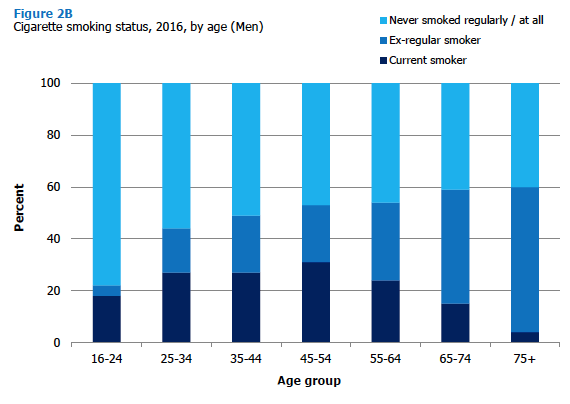
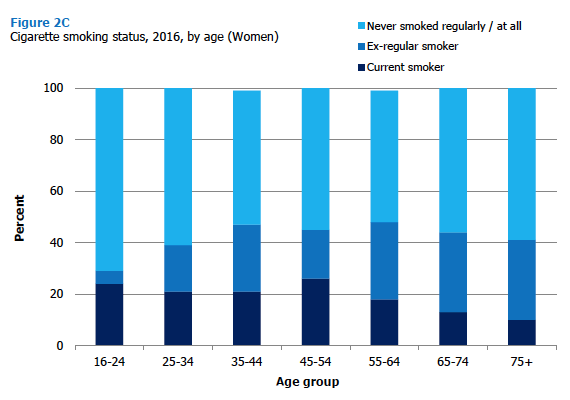
2.3.3 Cigarette smoking status by area deprivation (age-standardised), 2013-2016 combined
Adults living in more deprived areas were more likely to smoke than those in less deprived areas. The prevalence of smoking was 35% among those in the most deprived quintile areas compared with 11% among those in the least deprived quintile areas, with a step-decrease across the intermediate areas. The gradient was similar for men (38% in the most deprived areas compared with 12% in the least deprived areas) and women (33% in the most deprived areas compared with 10% in the least deprived areas).
Adults living in the least deprived areas were most likely to have never smoked or have never smoked regularly (65%) and those living in the most deprived quintile areas were least likely (41%), with step-decreases across the intermediate areas. This pattern held for both men and women.
There was a clear gradient in the numbers of cigarettes smoked by area deprivation with an average of 9.7 cigarettes smoked per day among smokers in the least deprived areas and 13.8 cigarettes smoked among those in the two most deprived quintile areas. The gradient was more pronounced among women, with a mean of 8.3 cigarettes smoked daily per current smoker living in the least deprived areas compared with 13.3 cigarettes smoked among those living in the most deprived areas. The corresponding numbers for male smokers were 11.0 cigarettes and 14.3 cigarettes, respectively.
There was no significant difference in the percentage of adults identifying as ex-regular smokers across area deprivation quintiles.
Figure 2D, Figure 2E, Table 2.3
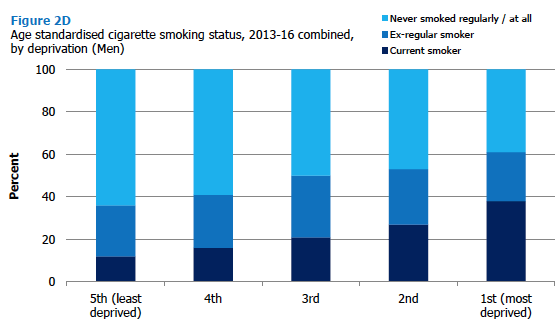
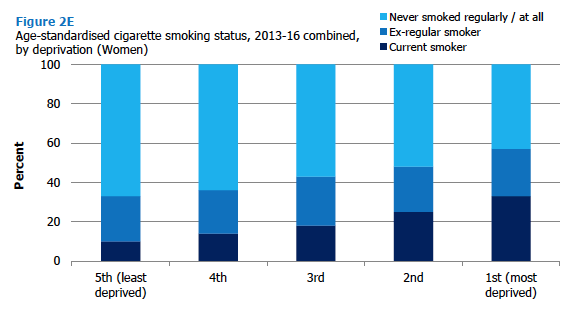
2.3.4 Cigarette smoking status by BMI (age-standardised), 2013-2016 combined
Smokers were more likely to be a normal weight (39%) than ex-regular smokers (29%) or those who have never smoked regularly (33%). Prevalence of obesity showed the reverse pattern with prevalence highest for ex-regular smokers (33%) and lowest for current smokers (24%). Levels of overweight (excluding obese) were higher for ex-smokers and those who had never smoked regularly (both 37%) than for current smokers (34%). The percentage of adults underweight was highest for smokers (4%) compared to 1% for both ex-smokers and those who have never regularly smoked.
There were some differences between men and women. Obesity levels were significantly higher for female smokers (28%) than for male smokers (19%), whilst levels of overweight (excluding obese) showed the reverse (38% for men and 30% for women). Male ex-regular smokers were less likely to be of a normal weight (25%) than women (33%) and more likely to be overweight (excluding obese) (43% compared to 32%). A similar difference was seen for those who were never regular smokers or had never smoked.
For those that currently smoke, the highest mean number of cigarettes smoked per day was among the under-weight group (18.2 cigarettes), though these results should be interpreted with some caution due to the small sample size for this group. The mean then dipped for those with healthy weight and those who were overweight (12.5% and 12.4% respectively). Then, for those in the obese category the mean number of cigarettes smoked per day was higher at 13.6. This pattern was more pronounced among men.
Table 2.4
2.4 E-Cigarette Use
2.4.1 E-cigarette use in 2014 to 2016
In 2016, current e-cigarettes use among adults was 7%; 12% had previously used e-cigarettes and 81% had never used them.
The proportion of current e-cigarette users has not changed from 2015, but is significantly higher than in 2014 (5% in 2014 compared with 7% in both 2015 and 2016). Fewer adults reported having never used e-cigarettes in 2016 (81%) than in 2014 (85%). The difference from 2015 (83%) is not statistically significant. Significantly more people had previously used e-cigarettes in 2016 than in 2014 (12% compared with 10%).
Men and women were equally likely to be current users of e-cigarettes (7% for both men and women). However, men were more likely to have previously used e-cigarettes than women (13% compared with 10%) and more women than men had never used e-cigarettes (83% compared with 79%).
As in previous years,[24] e-cigarette use in 2016 varied significantly with age. The prevalence of e-cigarette use in 2016 was highest among the middle age groups (8-10% among those aged 25-64) and lower for the youngest (4% among individuals aged 16-24) and older adults (1-4% for those aged 65 and over). A similar age-related pattern was seen for both men and women.
Combined past and current usage was also associated with age in 2016. Of those aged 16-54, 22-25% had ever used e-cigarettes compared with 19% of those aged 54-65, 9% of those aged 65-74 and 4% of those aged 75 and over. For those aged 45-74, around half of those who had ever used e-cigarettes (9-22%) were still using them (4-10%). Around a fifth of adults aged 16-24 who had ever used e-cigarettes were currently using them (4% were current users compared with 22% that reported having ever used e-cigarettes).
Table 2.5
2.5 Exposure To Second-Hand Smoke
2.5.1 Trends in non-smokers' exposure to second-hand smoke
The percentage of non-smokers reporting being exposed to second-hand smoke in their own or other people's homes has dropped from 25% in 2003 to 12% in 2016, with similar trends for men and women. There was no significant difference in exposure to second-hand smoke in their own or other people's homes between men (11%) and women (12%) in 2016.
Data on second-hand smoke exposure in any public place in 2016 are only comparable with data collected since 2012 due to changes in definitions (see footnotes to Table 2.6). Under the definition used in recent years, the percentage of adult non-smokers exposed to second-hand smoke in any public place has not changed significantly since 2012, with percentages remaining between 16% and 18%. There was no significant difference between men and women non-smokers’ exposure to second-hand smoke in any public place in 2016 (16% for men and 17% for women).
Non-smokers' were asked to state their exposure to second-hand smoke in their or other people’s homes, at work, outside buildings, in cars / vans and in other public places, with these data being collected from 2012 onwards. In each of the 2012, 2013, and 2014 surveys 70% of non-smokers said they had not been exposed to smoke in any of these places; this rose significantly to 74% in 2015 and was 73% in 2016.
Table 2.6
2.5.2 Non-smokers' exposure to second-hand smoke (age-standardised) by area deprivation in 2016
The percentage of non-smokers reporting being exposed to second-hand smoke in their own or other people's homes was significantly associated with deprivation (8% and 5% in the two least deprived area quintiles compared with 20% in the most deprived area quintile) with no significant difference between men and women.
There was no area deprivation gradient for the percentages of adult non-smokers exposed to second-hand smoke in any public place in 2016. This was the case for both men and women.
Table 2.7 provides the age-standardised percentages of adult non-smokers that said they had not been exposed to smoke in their or other people’s homes, at work, outside buildings, in cars / vans or in other public places by area deprivation for 2016. The percentage that said they had not been exposed to smoke at any of these places differed significantly between the two most deprived area quintiles (64% and 69%) and the three least deprived area quintiles (75-79%), with similar trends and levels for men and women.
Table 2.7
2.5.3 Children's exposure to second-hand smoke since 2012
In 2016, 11% of children lived in accommodation in which someone regularly smoked inside. There was a statistically significant difference by sex, with a higher percentage of boys affected (12% of boys and 9% of girls). There was no significant difference between the 2016 figure for all children and the 2015 figure of 12% although previously significant decreases were seen in the years between 2012 to 2015 (19% in 2012, 16% in 2013 and 2014, and 12% in 2015). Similar patterns were observed for both boys and girls.
A lower percentage of children (7% for both boys and girls) were reported to have been exposed to second-hand smoke in their home in 2016 than in 2012 (12%). The lowest percentage so far was in 2015 (6%).
The data indicate that the target to reduce the percentage of children exposed to smoke at home to 6% by 2020 was met in 2015. There has been a slight increase to 7% in 2016, although this change is not statistically significant. These figures (and the others in this section) will continue to be examined in future years to assess adherence to the target.
Table 2.8
2.5.4 Children's exposure to second-hand smoke by area deprivation in 2016
There was a marked gradient by area deprivation for children who lived in accommodation in which someone smoked inside (from 3% for those living in the least deprived areas to 23% for those living in the most deprived areas). This deprivation gradient was equally pronounced for girls and boys.
Although the overall percentage of children reported to have been exposed to second-hand smoke at home in 2016 (7%) was close to the 2020 target of 6%, the percentage varied across area deprivation quintiles. For those living in the least deprived quintile areas, 1% of children were reported to be exposed to second-hand smoke in their home whereas the figure was 15% for those living in the most deprived quintile areas. There was a comparable statistically significant pattern for both boys and girls.
Contact
Email: Julie Landsberg, Julie Landsberg
Phone: 0300 244 4000 – Central Enquiry Unit
The Scottish Government
St Andrew's House
Regent Road
Edinburgh
EH1 3DG
There is a problem
Thanks for your feedback
